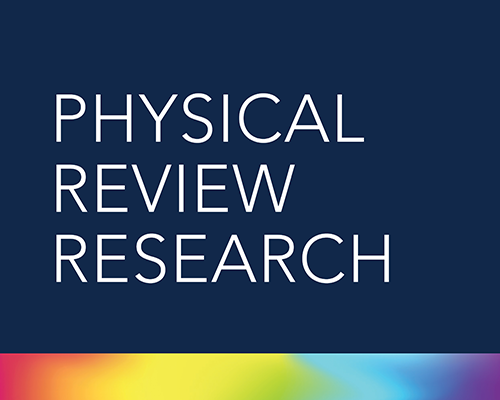To launch its inaugural issue, Physical Review Research has published its first content less than two months since opening for submissions in June.
Demonstrating the journal’s broad, multidisciplinary scope covering all of physics and related fields of interest to the physics community, the first release of peer-reviewed research articles includes advances in the areas of materials science, quantum information, soft matter, plasma science, optics, and condensed matter physics. Other papers accepted into the first issue of the journal were authored by researchers working in chemical physics, topological physics, complex systems, astrophysics, particles and fields, atomic and molecular physics, and other subject areas.
“When you submit a manuscript to Physical Review Research it is handled by a collaborative effort across the entire APS editorial team of Ph.D. scientists and professional support staff who manage the peer review for all of the Physical Review journals,” notes Juan-José Liétor-Santos, Managing Editor. “This ensures submissions from all subject areas receive the editorial expertise necessary to provide authors with an efficient and effective peer review experience.”
In addition to peer-reviewed research content, the first issue also contains two opening editorials. In the first, APS Editor in Chief Michael Thoennessen describes the rationale behind the structure of the editorial leadership for the new journal.

“To effectively cover the topical breadth and geographic range of this multidisciplinary, international peer-reviewed journal, we have committed to appointing a diverse and global team of esteemed active researchers to serve as Lead Editors and Editorial Board members,” explains Thoennessen. “I am extremely pleased to announce that Professors Raissa D’Souza, Jian-Wei Pan, and Nicola Spaldin have agreed to serve as the founding co-Lead Editors of Physical Review Research and represent the journal within their respective regions and research communities.”
The second editorial is co-authored by D’Souza, Pan, Spaldin, and Liétor-Santos, and lays out the editors’ shared vision for Physical Review Research. “In addition to maximizing reach and readership through open access, by covering the full scope of activities in physics and associated disciplines, we will provide an integrated and cohesive view of the forefront of modern physics for our readers and create an outlet for research that addresses the interdisciplinary challenges that we face in modern society.”
The editors also define the relationship between the new journal and the other titles in the Physical Review family, noting that the editorial standards and acceptance criteria of Physical Review Research are similar to those of Physical Review A-E, Physical Review Applied, Physical Review Fluids, and Physical Review Materials. “Our goal is to establish a publication that offers the same experience and quality that we value and trust, while increasing authors’ choice within the Physical Review portfolio,” note D’Souza, Pan, Spaldin, and Liétor-Santos in their editorial. “As such, we welcome authors of quality manuscripts not accepted by Physical Review X or Physical Review Letters to seamlessly transfer their work to be considered for publication in Physical Review Research.”
As the fourth fully open access, online-only journal published by APS, all Physical Review Research content is immediately free to read upon publication and allows reuse by readers world-wide under a CC-BY 4.0 International license. To allow all authors an opportunity to experience this exciting new offering, APS is waiving article publication charges (APCs) for all manuscripts submitted in 2019 and subsequently published in Physical Review Research.
“All of us at APS who are involved with the Physical Review journals care deeply about their ongoing significance to science, are excited about this new endeavor, and are dedicated to delivering the excellence our communities expect from us via this new member of the journal family,” states Thoennessen in the closing lines of his editorial. “We hope that Physical Review Research will initiate conversations across traditional boundaries, reveal new opportunities for collaboration, and facilitate future discoveries, and thus directly support the aim of the APS to advance scientific discovery and research dissemination.”
©1995 - 2024, AMERICAN PHYSICAL SOCIETY
APS encourages the redistribution of the materials included in this newspaper provided that attribution to the source is noted and the materials are not truncated or changed.
Editor: David Voss
Staff Science Writer: Leah Poffenberger
Contributing Correspondent: Alaina G. Levine
Publication Designer and Production: Nancy Bennett-Karasik
August/September 2019 (Volume 28, Number 8)
Articles in this Issue

